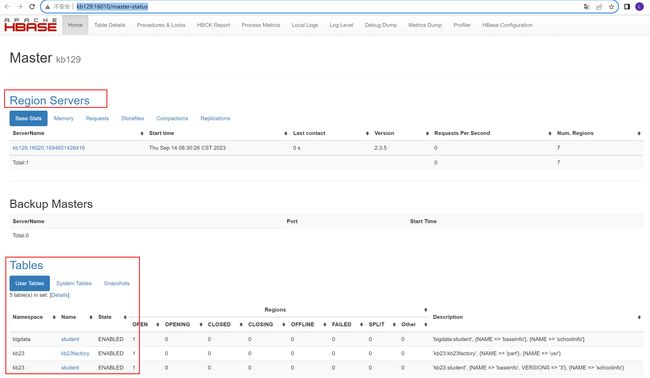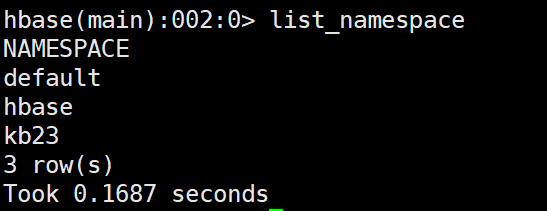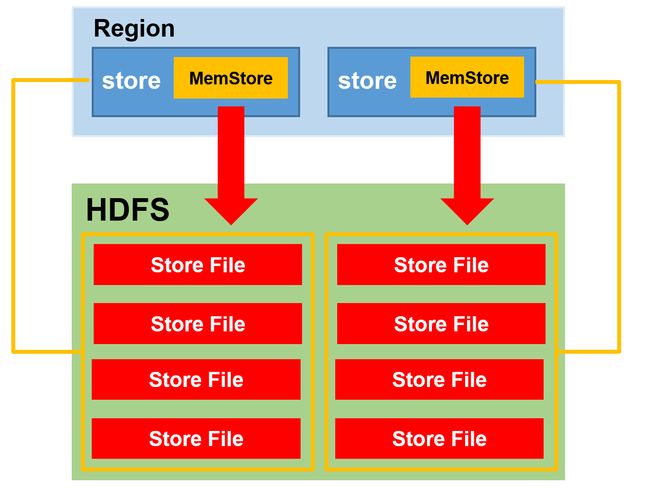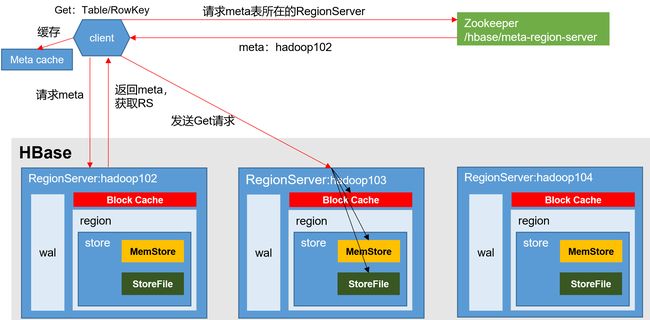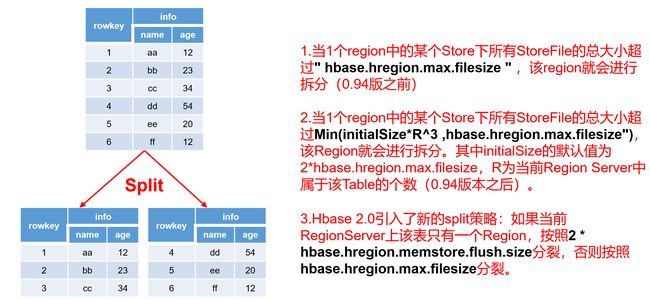Hadoop-Hbase
1. Hbase安装
| 1.1 安装zookeeper、 hbase 解压至/opt/soft,并分别改名 配置环境变量并source生效 #ZK export ZOOKEEPER_HOME=/opt/soft/zk345 export PATH=$ZOOKEEPER_HOME/bin:$PATH #HBASE_HOME export HBASE_HOME=/opt/soft/hbase235 export PATH=$HBASE_HOME/bin:$PATH hbase235/conf目录下的 编辑hbase-env.sh:[root@kb129 conf]# vim ./hbase-env.sh export JAVA_HOME=/opt/soft/jdk180 编辑hbase-site.xml [root@kb129 conf]# vim ./hbase-site.xml 拷贝配置文件准备配置zookeeper [root@kb129 conf]# pwd /opt/soft/zk345/conf [root@kb129 conf]# cp zoo_sample.cfg zoo.cfg 创建目录 [root@kb129 conf]# mkdir /opt/soft/zk345/logs [root@kb129 conf]# mkdir /opt/soft/zk345/zkdata 编辑配置文件,增加目录指向 [root@kb129 conf]# vim ./zoo.cfg 追加节点id [root@kb129 conf]# cd ../zkdata/ [root@kb129 zkdata]# echo "0">myid 启动zookeeper [root@kb129 zkdata]# zkServer.sh start 启动hbase (启动前解决Hbase和hadoop中log4j的jar包冲突报错问题:将Hbase中的jar包改名就不会读取,解决掉冲突报错:mv /opt/soft/hbase235/lib/client-facing-thirdparty/slf4j-log4j12-1.7.30.jar /opt/soft/hbase235/lib/client-facing-thirdparty/slf4j-log4j12-1.7.30.jar.bak) [root@kb129 zkdata]# start-hbase.sh 网页访问http://kb129:16010/ |
2.Hbase shell相关操作
| [root@kb129 conf]# hbase shell 创建命名空间 hbase(main):001:0> create_namespace 'kb23' 查看命名空间 hbase(main):001:0>list _namespace 创建表 hbase(main):007:0> create 'bigdata:student','baseinfo','schoolinfo' 查看表 hbase(main):008:0> list_namespace_tables 'bigdata' 查看描述 hbase(main):009:0> desc 'bigdata:student' 删除表之前先禁用表 禁用表 hbase(main):011:0> disable 'bigdata:student' 查看是否禁用/启用 hbase(main):011:0> is_disabled/is_enabled 'bigdata:student' 启用表 hbase(main):011:0> enable 'bigdata:student' 插入数据(原有数据的话会覆盖) hbase(main):006:0> put 'bigdata:student','rowkey1','baseinfo:name','tom' 查看指定rowkey的所有数据 hbase(main):008:0> get 'bigdata:student','rowkey1' COLUMN CELL baseinfo:age timestamp=2023-09-13T14:21:26.095, value=30 baseinfo:name timestamp=2023-09-13T14:21:22.385, value=tom 查看指定列族数据 hbase(main):011:0> get 'bigdata:student','rowkey1','baseinfo' COLUMN CELL baseinfo:age timestamp=2023-09-13T14:21:26.095, value=30 baseinfo:name timestamp=2023-09-13T14:21:22.385, value=tom 查看指定列族中某列数据 hbase(main):012:0> get 'bigdata:student','rowkey1','baseinfo:name' COLUMN CELL baseinfo:name timestamp=2023-09-13T14:21:22.385, value=tom 添加列族 hbase(main):021:0> alter 'kb23:student','teacherinfo' 删除列族 hbase(main):023:0> alter 'kb23:student',{NAME=>'teacherinfo',METHOD=>'delete'} 更改版本个数(VERSIONS默认为1) hbase(main):026:0> alter 'kb23:student',{NAME=>'baseinfo',VERSIONS=>3} 全表扫描 hbase(main):027:0> scan 'kb23:student' 删除指定列族中的列 hbase(main):055:0> delete 'kb23:student','rowkey2','baseinfo:name' 删除所有rowkey2信息 hbase(main):060:0> deleteall 'kb23:student','rowkey2' 查看不同版本信息 hbase(main):070:0> get 'kb23:student','rowkey1',COLUMN=>'baseinfo:name',VERSIONS=>3 查看范围内rowkey的数据(左闭右开) hbase(main):094:0> scan 'kb23:student', {COLUMNS => 'baseinfo:name', STARTROW => 'rowkey',STOPROW=> 'rowkey3'} 查看时使用limit hbase(main):096:0> scan 'kb23:student', {COLUMNS => 'baseinfo:name', STARTROW => 'rowkey',STOPROW=> 'rowkey3', VERSIONS=> 3, LIMIT=> 1} 过滤查找value包含11开头的信息(可查到多个版本) hbase(main):099:0> scan 'kb23:student',FILTER=>"ValueFilter(=,'binary:11')" 过滤查找value包含andemen开头的信息(可查到多个版本) hbase(main):102:0> scan 'kb23:student',FILTER=>"ValueFilter(=,'substring:andemen')" 过滤查找列名birth开头的信息(可查到多个版本) hbase(main):104:0> scan 'kb23:student',FILTER=>"ColumnPrefixFilter('birth')" 多条件AND查询 hbase(main):110:0> scan 'kb23:student',FILTER=>"ColumnPrefixFilter('birth') AND ValueFilter(=,'substring:200')" AND或OR查询 hbase(main):005:0>scan 'kb23:student',FILTER=>"ColumnPrefixFilter('birth') AND (ValueFilter(=,'substring:200')) OR ValueFilter(=,'substring:20')" |
3.Hbase运行原理
| 3.1 HBase物理架构 1)StoreFile 保存实际数据的物理文件,StoreFile以Hfile的形式存储在HDFS上。每个Store会有一个或多个StoreFile(HFile),数据在每个StoreFile中都是有序的。 2)MemStore 写缓存,由于HFile中的数据要求是有序的,所以数据是先存储在MemStore中,排好序后,等到达刷写时机才会刷写到HFile,每次刷写都会形成一个新的HFile。 3)WAL 由于数据要经MemStore排序后才能刷写到HFile,但把数据保存在内存中会有很高的概率导致数据丢失,为了解决这个问题,数据会先写在一个叫做Write-Ahead logfile的文件中,然后再写入MemStore中。所以在系统出现故障的时候,数据可以通过这个日志文件重建。 4)BlockCache 读缓存,每次查询出的数据会缓存在BlockCache中,方便下次查询。 |
| 3.2 写流程 1)Client先访问zookeeper,获取hbase:meta表位于哪个Region Server。 2)访问对应的Region Server,获取hbase:meta表,根据写请求的namespace:table/rowkey,查询出目标数据位于哪个Region Server中的哪个Region中。并将该table的region信息以及meta表的位置信息缓存在客户端的meta cache,方便下次访问。 3)与目标Region Server进行通讯; 4)将数据顺序写入(追加)到WAL; 5)将数据写入对应的MemStore,数据会在MemStore进行排序; 6)向客户端发送ack; 7)等达到MemStore的刷写时机后,将数据刷写到HFile。 |
| 3.3 MemStore Flush MemStore刷写时机: 1.当某个memstroe的大小达到了hbase.hregion.memstore.flush.size(默认值128M),其所在region的所有memstore都会刷写。 当memstore的大小达到了 hbase.hregion.memstore.flush.size(默认值128M)* hbase.hregion.memstore.block.multiplier(默认值4)时,会阻止继续往该memstore写数据。 2.当region server中memstore的总大小达到 java_heapsize*hbase.regionserver.global.memstore.size(默认值0.4)*hbase.regionserver.global.memstore.size.lower.limit(默认值0.95), region会按照其所有memstore的大小顺序(由大到小)依次进行刷写。直到region server中所有memstore的总大小减小到上述值以下。 当region server中memstore的总大小达到 java_heapsize*hbase.regionserver.global.memstore.size(默认值0.4)时,会阻止继续往所有的memstore写数据。 3. 到达自动刷写的时间,也会触发memstore flush。自动刷新的时间间隔由该属性进行配置hbase.regionserver.optionalcacheflushinterval(默认1小时)。 4.当WAL文件的数量超过hbase.regionserver.max.logs,region会按照时间顺序依次进行刷写,直到WAL文件数量减小到hbase.regionserver.max.log以下(该属性名已经废弃,现无需手动设置,最大值为32)。 |
| 3.4 读流程 1)Client先访问zookeeper,获取hbase:meta表位于哪个Region Server。 2)访问对应的Region Server,获取hbase:meta表,根据读请求的namespace:table/rowkey,查询出目标数据位于哪个Region Server中的哪个Region中。并将该table的region信息以及meta表的位置信息缓存在客户端的meta cache,方便下次访问。 3)与目标Region Server进行通讯; 4)分别在MemStore和Store File(HFile)中查询目标数据,并将查到的所有数据进行合并。此处所有数据是指同一条数据的不同版本(time stamp)或者不同的类型(Put/Delete)。 5)将查询到的新的数据块(Block,HFile数据存储单元,默认大小为64KB)缓存到Block Cache。 6)将合并后的最终结果返回给客户端。 |
| 3.5 StoreFile Compaction 由于memstore每次刷写都会生成一个新的HFile,且同一个字段的不同版本(timestamp)和不同类型(Put/Delete)有可能会分布在不同的HFile中,因此查询时需要遍历所有的HFile。为了减少HFile的个数,以及清理掉过期和删除的数据,会进行StoreFile Compaction。 Compaction分为两种,分别是Minor Compaction和Major Compaction。Minor Compaction会将临近的若干个较小的HFile合并成一个较大的HFile,并清理掉部分过期和删除的数据。Major Compaction会将一个Store下的所有的HFile合并成一个大HFile,并且会清理掉所有过期和删除的数据。 |
| 3.6 Region Split 默认情况下,每个Table起初只有一个Region,随着数据的不断写入,Region会自动进行拆分。刚拆分时,两个子Region都位于当前的Region Server,但处于负载均衡的考虑,HMaster有可能会将某个Region转移给其他的Region Server。 Region Split时机: 1.当1个region中的某个Store下所有StoreFile的总大小超过hbase.hregion.max.filesize (10G),该Region就会进行拆分(0.94版本之前)。 2.当1个region中的某个Store下所有StoreFile的总大小超过Min(initialSize*R^3 ,hbase.hregion.max.filesize"),该Region就会进行拆分。其中initialSize的默认值为2*hbase.hregion.memstore.flush.size,R为当前Region Server中属于该Table的Region个数(0.94版本之后)。 具体的切分策略为: 第一次split:1^3 * 256 = 256MB 第二次split:2^3 * 256 = 2048MB 第三次split:3^3 * 256 = 6912MB 第四次split:4^3 * 256 = 16384MB > 10GB,因此取较小的值10GB 后面每次split的size都是10GB了。 3.Hbase 2.0引入了新的split策略:如果当前RegionServer上该表只有一个Region,按照2 * hbase.hregion.memstore.flush.size分裂,否则按照hbase.hregion.max.filesize分裂。 |
4.hive映射hbase
| hive中创建表格,关联hbase中的表 (1) (2)rowkey之间不同字段 |
5.Hbase API
| 5.1 pom依赖 |
| 5.2 增删改查等具体操作 |
| 5.3 写缓存 HBase客户端的批量写缓存BufferedMutator HBase的每一个put操作实际上是一个RPC操作,将客户端的数据传输到服务器再返回结果,这只适用于小数据量的操作,如果数据量多的话,每次put都需要建立一次RPC的连接(TCP连接),而建立连接传输数据是需要时间的,因此减少RPC的调用可以提高数据传输的效率,减少建立连接的时间和IO消耗。 HBase的客户端API提供了写缓存区,put的数据一开始放在缓存区内,当数量到达指定的容量或者用户强制提交是才将数据一次性提交到HBase的服务器。这个缓冲区可以通过调用 HTable.setAutoFlush(false) 来开启。而新版HBbase的API中使用了BufferedMutator替换了老版的缓冲区,通过BufferedMutator对象提交的数据自动存放在缓冲区中。 BufferedMutator 通过获取 BufferedMutator 对象,并调用 mutator.mutate(List |




